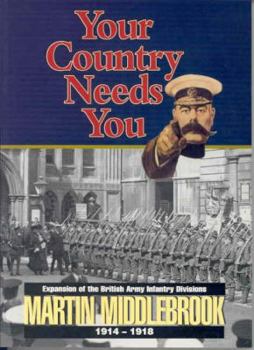Your Country Needs You!: Expansion of the British Army Infantry Divisions 1914-1918
The heavy casualties of the battles of 1914 and 1915, the entry of Turkey into the war in 1915, and the unreliability of the French and Italian armies placed great strains on Britain's existing... This description may be from another edition of this product.
Format:Paperback
Language:English
ISBN:0850527112
ISBN13:9780850527117
Release Date:January 2001
Publisher:Pen & Sword Books
Length:174 Pages
Weight:1.30 lbs.
Dimensions:0.7" x 6.5" x 9.7"
Related Subjects
HistoryCustomer Reviews
1 rating
Mobilization A to Z
Published by Thriftbooks.com User , 22 years ago
At first glance, a book about the mobilization of British infantry divisions in the First World War might not seem like a very interesting subject. Look again, and note that this book is written by Martin Middlebrook, one of the most readable authors on the First World War. Middlebrook initially pulled this material together as a reference guide intended only for his own purposes, but then realized that he had the essence of a viable book and decided to publish it. As with any Middlebrook effort, the result is worthwhile. The value of this book, beyond the mere enumeration of data on every British division in the war, is that it serves to explain the strengths and weakness of the British Army in the First World War - much of which was attributable to mobilization policies. Your Country Needs You consists of eight chapters, with the first six covering the different types of infantry divisions: regulars, the New Army, the Pals, the First-Line and Second-Line Territorials. The last two chapters cover the changing army after 1916 and the final year of the war. Two appendices detail the wartime expansion of a typical British regiment and the casualties suffered by each British regiment in the war. Only infantry units from the Home Islands are covered, but Middlebrook does address other Commonwealth forces and support units when appropriate. The 200+ photographs in the volume are also excellent and many have not appeared elsewhere (e.g. a photo of a British army recruiting desk in New York City circa 1915 - apparently the "neutral" USA allowed Allied recruiting of their nationals in our country). Middlebrook provides an entry detailing the formation, composition and deployment of each of the 65 infantry divisions that saw active service in the First World War, although the regulars receive far-less coverage than the newly-raised units. Although Middlebrook is loathe to criticize the British mobilization effort, which was able to increase the army from 6 to 65 divisions in less than two years, it is apparent that mistakes made in the program severely degraded Britain's ability to conduct sustained combat operations on the continent. Before the war, Lord Haldane had established the Territorials (similar to the US National Guard) and an Officer Training Corps (OTC) to provide for a mobilization base to backstop the tiny regular army. However, Haldane was replaced at the start of the war by Field Marshal Kitchener, who decided to improvise an ad hoc force known as "the New Army." On top of this, volunteer units known as "Pal" units were raised by various localities and Kitchener decided to incorporate them into his New Army structure. The result was three different sources of infantry divisions, all forming from different manpower sources and with varying training standards. Furthermore, there was a severe shortage of trained officers, NCOs, and support units to fully equip the new units. Most of the New Army units had to rely on over-age





